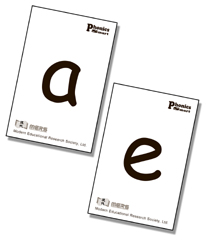| Phonics
is essential to English learning. Do you agree? Phonics involves
teaching children how to connect sounds with letters or groups of
letters. It helps learners develop graphophonic strategies to decode
and encode words, thus enhances learners' reading, listening and
speaking skills. It appears to be an essential 'tool' to upgrade
learners' English proficiency. However, as generally known by educators
and even parents, only 70% of all English words follow the phonics
rules and patterns, and the English language can be best decoded
with the use of other methods, such as International Phonetic Symbols.
Why do we still adopt phonics teaching and activities in daily English
teaching? The argument has gone on for centuries and it has remained
as one of the most controversial issues in children literacy.
 |
 |
It is believed that phonics teaching arrived
on the scene as early as the reform of the Catholic Church. Martin
Luther King Sr. launched his propaganda against the Church in the
16th Century. At that time, Latin was the 'sacred' language and
no other language was allowed in any church of God. However, only
educated people understood Latin, therefore, the vast majority of
believers could not comprehend the messages taught in service or
in the Bible. To help believers understand the words of God, Martin
Luther started to translate the Latin Bible into English and printed
the words of God on pamphlets and posters. Nevertheless, the job
of teaching the Bible could not be done unless believers became
literate. The teaching of English alphabets and combinations of
them then became a must in the Church Reformation. After two hundred
years of trialing and drilling, educators learnt their ways to teach
the sounds of alphabets naturally, and principles were set and elaborated.
However, they could not reach consensus on an organized and systematic
approach of phonics teaching.
 |
Phonics evolves naturally as nothing additional was
created, such as symbols, to complicate its teaching. It blends
perfectly in with the English language and goes hand in hand with
the English reading principles. English spelling is based upon the
alphabetic principle, the idea that letters represent sounds. For
example, the word fat is composed of three letters, f,
a, and t, each representing a phoneme, respectively,
/f/, /a/, and /t/.
However, not every word can be decoded by
phonics. Reading in English also requires understanding of additional
patterns that go beyond the 'one letter - one sound' principle.
For example, the word first is composed of five letters
which represent only three sounds, /f/, /ε/, /s/ and /t/.
Even more complex principles can be found
in the English language. For example, the grapheme ough represents /Λf/ as in enough, /ou/ as in though,
/u/ as in through, as
in cough, and as
in cough, and in bough. To avoid confusion, teachers rarely teach the pattern
for the letters ough. Because of such large body of complex
and conflicting patterns, primary school children often learn a
selection of consistent patterns only. in bough. To avoid confusion, teachers rarely teach the pattern
for the letters ough. Because of such large body of complex
and conflicting patterns, primary school children often learn a
selection of consistent patterns only.
Despite the fact that complicated patterns
exist in phonics teaching and only consistent rules are taught in
schools, the vitality and practicality of phonics teaching should
not be undermined. To primary school children, selected phonics
rules and patterns are sufficient for them to decode the English
language because of the limited words they are exposed to, especially
in circumstances that English is being taught as a second language.
Although other methods, such as International Phonetic Symbols,
can decode every words of the English language, if they are to be
used instead in introducing the language, children need to first
master a set of new symbols before learning the language.
In 1980s, the debate polarized when the
whole language approach arrived on the scene. Whole language instruction
holds the principle that children learn to read when they have proper
motivation, are given access to quality literature and many reading
opportunities. It also emphasizes on understanding meaning of English
words and using meaning clues to determine the pronunciation of
unknown words. Debates on phonics? effectiveness in teaching English
arose since more focus should be put on meaning rather than sound,
as suggested in the approach. However, proven by experience and
learning outcomes, the phonics rules and patterns do give a hand
in helping children determine pronunciation of unknown words, which
is another focus of the approach. And it is also believed that pupils,
by learning the alphabetic code early through phonics, could spare
their mental energy for word analysis and meaning, leading to stronger
comprehension. This matches perfectly the goal of the whole language
approach.
The debate continues even nowadays. However,
more focuses are now on the different approaches of phonics teaching.
Three of the common approaches are worthy of notice because of their
frequent occurrence in nowadays phonics teaching.
Synthetic phonics involves investigating
the sound of every single letter or combinations of letters of a
word as individual sound and then blending those sounds together.
For example, shout would be read by pronouncing the sounds for each
single letter or combinations of letters '/∫/, au/, t/' and then
blending those sounds orally to produce a spoken word, '/∫aut/'
Synthetic phonics instruction requires that pupils identify the
sound-symbol correspondences and blend their phonemes automatically.
Analogy phonics requires learners to identify
the phonograms in a word. A phonogram, known in linguistics as a
rime, is composed of the vowel and all the sounds that follow it.
Teachers using the analogy method assist pupils in memorizing a
bank of phonograms, such as -at or -am, thus enabling them to pronounce
large amount of unknown words. This is one of the most common approaches
adopted in Hong Kong primary schools.
Embedded phonics blends perfectly in with
the traditional whole language phonics programmes and it shares
the same rationales and methodology of phonics teaching in Hong
Kong. Phonics is taught in context of literature using 'mini-lessons',
in which phonics elements are emphasized.\
In Hong Kong, as suggested in the English
Language Curriculum Guide (Primary 1-6), 2004, phonics teaching
is part of the curriculum and it is regarded as a must in regular
English teaching. It is suggested to be taught in regular lessons,
with meaningful context and appropriate text types. To facilitate
both teachers and learners, Modern Educational Research Society
Ltd. has published a set of phonics materials for local schools.
Our Phonics
Smart
package includes phonics materials suitable for young learners in
kindergartens and primary schools. Following the guidelines given
by the Curriculum Development Council, all the letter sounds are
introduced in different text types, such as songs and rhymes and
is further consolidated with actions, gestures, games or other activities.
The package adopts mainly the synthetic phonics approach, teaching
learners to investigate the sound of single letters or combination
of letters in a systematic way. By doing so, learners become more
confident and capable of pronouncing unfamiliar words or even unknown
words. The lessons are short and well thought-out with clear teaching
steps and presentation.
 |
More details and characteristics of the
product are listed below:
‧ Adopts task-based learning with clear pre-task, while-task and
post-task stages.
‧ A core activity forms the centre of each lesson.
‧ A physical action is suggested in each lesson to strengthen learners?letter-sound
relationship,
‧ A note on Letter/sound
Awareness is included for teacher's
own reference on the sound(s) to be taught.
‧ An Activity Bank
is included at the end of each book to suggest various activities
to enhance class participation and facilitate learners' memory.
‧ A Reading List
‧Teaching aids such as posters, CD-ROMs, audio CDs, picture flashcards
and letter flashcards are also included.
Teachers will find the package easier
to use and learners will love the package because of its beautiful
illustrations and funful activities.
Phonics has come a long way to establish
itself as one of the essential components in English Learning. Despite
its controversy, phonics teaching is proven to be an effective way
to teach English pronunciation, especially for younger learners,
and with several hundred years of trialing and debates, appropriate
approaches can be found and adopted to maximize its effectiveness.
To look beyond the history of debates, more emphasizes and energy
should be directed to investigating even better ways to teach phonics.
Modern Educational Research Society, Ltd. will continue to work
closely with teachers and educators to create up-to-date and useful
materials for learners in Hong Kong.
Bill
Schnarr (2004). The History of
Phonics - The Oldest Argument in the World. Net Guides Publishing,
Inc.
The
Curriculum Development Council (2004) English Language Education
Key Learning Area: English Language
Curriculum Guide (Primary 1-6). The Education and Manpower
Bureau HKSAR |